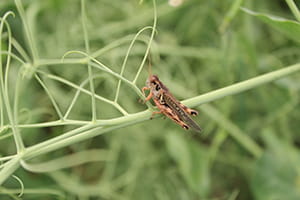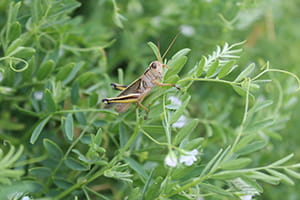By Shannon Chant, MSc PAg, Crops Extension Specialist, Swift Current
April 2024
There are over 85 species of grasshoppers in Western Canada, but most of them don’t significantly impact agriculture.
Four main species of grasshoppers cause economic damage to crops in Saskatchewan. These species all overwinter as eggs and have five nymphal instars before becoming adults. Information from this article came from Dr. James Tansey and Agriculture and Agri-Food Canada’s Field Crop and Forage Pests and their Natural Enemies in Western Canada: Identification and Management.
The main pest species in recent outbreaks is the two-striped grasshopper:
Identification of adults:
- Brownish or greenish with black or brown markings.
- Two pale stripes extending back from the eyes to the tip of the forewings.
- Each hind leg has a solid, longitudinal black stripe.
- One to just over one and a half inches long.
Habitat and preferred food source:
- Eggs are concentrated in roadsides and ditches and hatch in May.
- Prefer moist areas of lush vegetation in heavier textured soil zones and meadows.
- Preferred food source is lush foliage, such as weed species found in marshes and roadside ditches.
- Wide range of plants it will feed on including broadleaf crops, including alfalfa and annual pulses, cereals and grasses
This grasshopper species is also migratory.

The second species is the migratory grasshopper:
Identification of adults:
- Brownish to grayish body.
- Small, black stripe across the head.
- The first segment of their hind legs has black banding and the last two segments are red.
- Just under or just under one inch.
Habitat and preferred food source:
- Lay eggs in groups of 18 to 24 in the late summer at a depth of 0.8 inches.
- Each female can lay 250 eggs.
- The following May the eggs hatch.
- Hatching starts along open south slopes, in fields and rangeland with little vegetative cover, and in sandy soils.
- A broad host range and will eat anything.
- Prefer forbs, grasses, wheat, barley and other cereal crops.
- Will scavenge on ground litter, dead insects and dried manure.
Packard’s grasshopper is another pest species in the province:
Identification of adults:
- Gray to light yellow body.
- Two light-coloured stripes that extend from just behind the eyes to the end of the thorax.
- Last two segments on their hind legs are blue green.
- 1.25 to 1.4 inches.
Habitat and preferred food source:
- Prefer open habitats and light-textured soils.
- Eggs hatch in May/June.
- Preferred food is vegetables, small grains, legumes and thistles.

The final species is the clear-winged grasshopper:
Identification of adults:
- Yellowish to brownish body.
- Wings are clear but have dark patches on them.
- Two stripes begin at the thorax and join at the tips of the forewings.
- 0.8 to 1.25 inches long.
Habitat and preferred food source:
- Prefer open habitats and light-textured soils.
- Eggs hatch in May/June.
- Hatchlings emerge in the morning when temperatures are rising rapidly, especially after an evening shower.
- Primarily feeds on grasses.
How can you tell if it is a non-pest species?
An insect that looks like a grasshopper but has long antennae is not a grasshopper.
Insects that are not pests:
- Have wings before late June.
- Have brightly coloured hind wings.
- Are noisy flyers.
- Are callers or chirpers.
If you are looking for more information on grasshoppers, their identification and control, refer to our Grasshopper webpage, talk to your local crops extension specialist or call the Agriculture Knowledge Centre at 1-866-457-2377.
